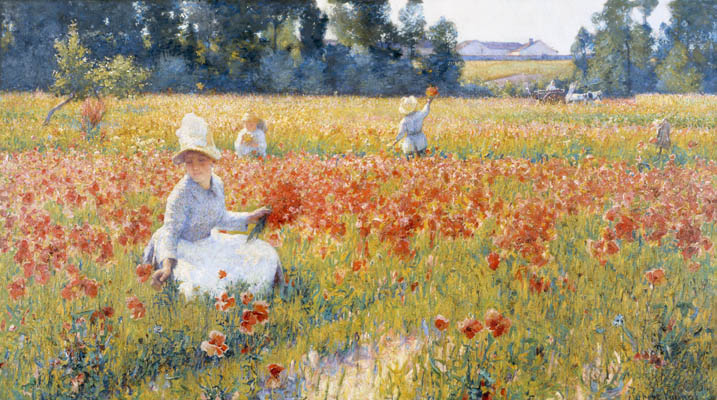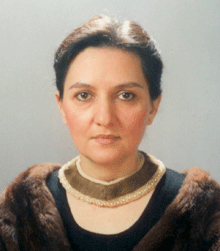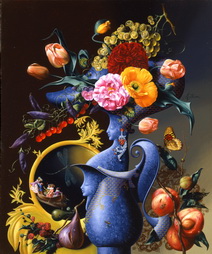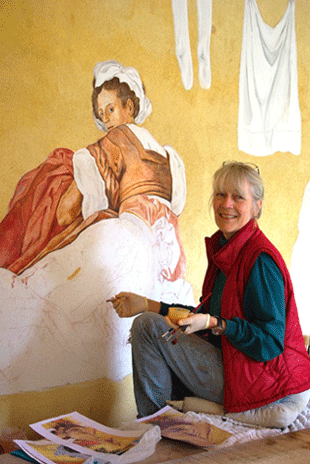
In the development of American Impressionism, Robert Vonnoh is significant both as a painter and as a teacher. He was one of the earliest painters to bring European impressionism to America and his canvases had cool tones and balanced compositions with much capturing of light and atmosphere. He completed more than 500 commissioned portraits, and he had a distinguished teaching career in Boston and Philadelphia.
Vonnoh was born in 1858 in Hartford, Connecticut and raised in Boston. He studied at the Massachusetts Normal Art School in 1875, and attended the Academie Julian in Paris in 1880. There he studied with Gustave Boulanger and Jules Joseph Lefebvre. In 1883, he returned to Boston where he taught at the Cowles School in 1884 and at the School of the Museum of Fine Arts in 1885.
The piece “In Flanders Field – Where Soldiers Sleep and Poppies Grow” is available for reproduction through the RequestAPrint gallery page found here.
Vonnoh studied French Impressionism and was impressed by Claude Monet, whose influence can be seen in his works of colorful landscapes and bright flowers. His painting at this time also demonstrates the dichotomy of many American Impressionists. Some of his works are almost Fauvist, with raw brilliant colors and paint laid on with wide brushes or palette knife, as in his painting “Poppies” in 1888. Other works from about the same time are done almost entirely in neutral tones, as in “Companion of the Studio”, a solid three-dimensional portrait of John C. Pinhey, who was a fellow student at the Julian Academy.
To see his legendary piece and order a reproduction for your own home visit RequestAPrint.
(Information Credit: gratzgallery.com)

 Mitzura Salgian is a Fine Artist with a masterful technique and reverence for detail. Her distinctive style is rooted in the Baroque richness of imagery and the Surrealist sense of marvelous to which she was drawn since her early teens. Mitzura is an American artist of Romanian origin. She was educated in her native city of Bucharest, where she received MFA from the Fine Arts Institute.
Mitzura Salgian is a Fine Artist with a masterful technique and reverence for detail. Her distinctive style is rooted in the Baroque richness of imagery and the Surrealist sense of marvelous to which she was drawn since her early teens. Mitzura is an American artist of Romanian origin. She was educated in her native city of Bucharest, where she received MFA from the Fine Arts Institute. Museum in Neenah, Wisconsin; the National Arts Club, the Salmagundi Club Galleries and the New York University Washington Square East Galleries, all in New York City; the Attleboro Arts Museum in Attleboro, Massachusetts; the Turtle Bay Museum in Redding, California; the Danville Museum of Fine Arts And History in Danville, Virginia; the Huntsville Museum of Art in Huntsville, Alabama; the Museum of Texas Tech University in Lubbock, Texas; the World Bank Auditorium in Washington, District of Columbia.
Museum in Neenah, Wisconsin; the National Arts Club, the Salmagundi Club Galleries and the New York University Washington Square East Galleries, all in New York City; the Attleboro Arts Museum in Attleboro, Massachusetts; the Turtle Bay Museum in Redding, California; the Danville Museum of Fine Arts And History in Danville, Virginia; the Huntsville Museum of Art in Huntsville, Alabama; the Museum of Texas Tech University in Lubbock, Texas; the World Bank Auditorium in Washington, District of Columbia.
 Gary T. Erbe was born in 1944 in Union City, NJ where he maintained his studio for 35 years. Self taught, he began painting in 1965. In the early years, every painting Erbe created would become a learning experience bringing him closer to understanding what makes good art. This was a challenging time for him. Then he discovered and became interested in Trompe l’oeil painting. In 1969, he conceived a way of creating Trompe l’oeil paintings that would be contemporary and different from the 19th Century Trompe l’oeil masters and coined the term “Levitational Realism”. In 1970, he quit his job as an engraver to pursue art fulltime and in the mid 1970’s, he began to explore the idiom of abstraction and cubism and how it can be applied to Trompe l’oeil painting. The idea of integrating modern principles into his painting was very challenging and exciting. Bridging the gap between modern art and realism would be his vision. In fact, today his work has less to do with Trompe l’oeil and more to do with the creative process.
Gary T. Erbe was born in 1944 in Union City, NJ where he maintained his studio for 35 years. Self taught, he began painting in 1965. In the early years, every painting Erbe created would become a learning experience bringing him closer to understanding what makes good art. This was a challenging time for him. Then he discovered and became interested in Trompe l’oeil painting. In 1969, he conceived a way of creating Trompe l’oeil paintings that would be contemporary and different from the 19th Century Trompe l’oeil masters and coined the term “Levitational Realism”. In 1970, he quit his job as an engraver to pursue art fulltime and in the mid 1970’s, he began to explore the idiom of abstraction and cubism and how it can be applied to Trompe l’oeil painting. The idea of integrating modern principles into his painting was very challenging and exciting. Bridging the gap between modern art and realism would be his vision. In fact, today his work has less to do with Trompe l’oeil and more to do with the creative process. Monica Allen Perin, a painter from her youth, began her fine art studies at the California College of Arts and Crafts, Oakland, California. She subsequently obtained a Masters degree in the decorative arts (Museum Studies) at the Fashion Institute of Technology in Manhattan and consecrated her theses to the garden frescoes found in and around Pompeii.
Monica Allen Perin, a painter from her youth, began her fine art studies at the California College of Arts and Crafts, Oakland, California. She subsequently obtained a Masters degree in the decorative arts (Museum Studies) at the Fashion Institute of Technology in Manhattan and consecrated her theses to the garden frescoes found in and around Pompeii.